Key takeaways:
- Wedding traditions connect generations and symbolize shared values, fostering a sense of belonging among families and communities.
- Personalization of traditions, such as writing vows or incorporating family elements, allows couples to reflect their unique journeys while honoring cultural roots.
- Interactive rituals, like the “wishing tree,” enhance guest involvement and create a collaborative atmosphere during celebrations.
- Global wedding customs, from the Indian Sangeet to the Jewish glass-breaking, showcase diverse cultural expressions that enrich the celebration of love.
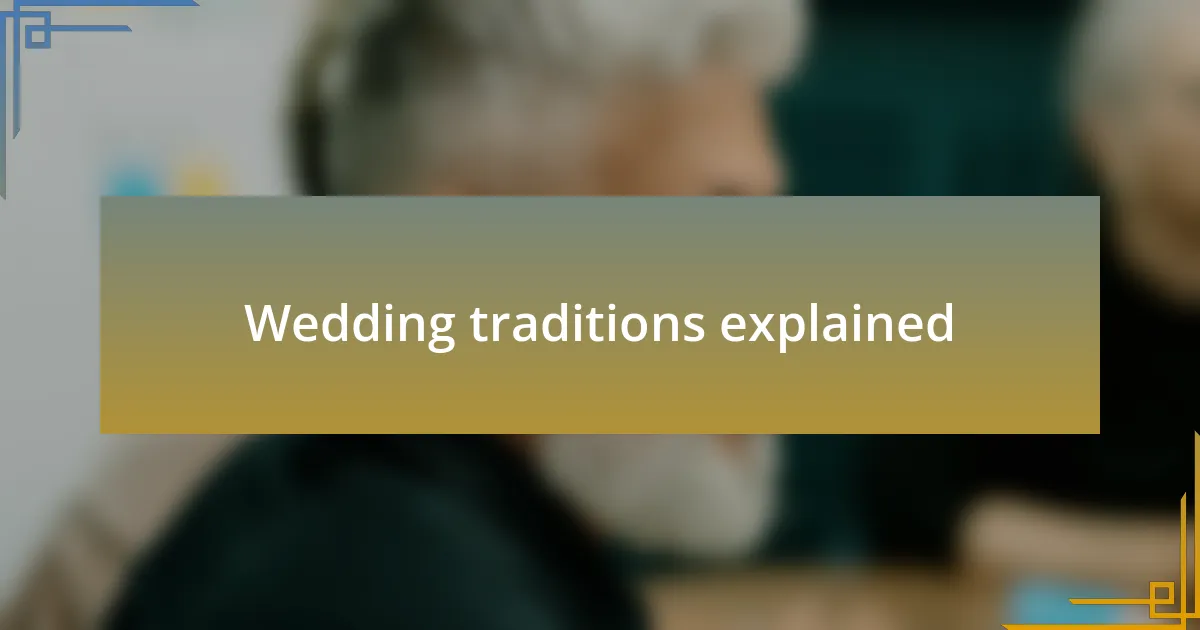
Wedding traditions explained
Wedding traditions serve as a beautiful thread that weaves together generations, each carrying its own significance. For instance, I remember attending a wedding where the couple honored their cultural roots by incorporating a traditional dance. It was incredibly moving to see family members come together, sharing laughter and stories, as they celebrated their heritage. Have you ever witnessed a ceremony that made you feel deeply connected to a culture you weren’t a part of?
In my experience, many wedding traditions stem from the desire to create a sense of belonging or to honor loved ones. When I was at my friend’s wedding, they had a meaningful ritual of lighting a unity candle, symbolizing the joining of two families. The warmth of that moment not only filled the room but also sparked conversations about the importance of family in our lives. Isn’t it fascinating how such simple acts can encapsulate profound emotions and sentiments?
Contrary to what some might believe, wedding traditions can adapt over time to resonate with modern couples. For example, I once attended a ceremony where the couple decided to write their own vows, blending traditional structures with personal touches that reflected their unique journey together. This creative twist on a classic tradition reminded me that while conventions hold value, the essence of a wedding lies in celebrating love as each couple sees fit. How do you envision putting your own spin on cherished customs?

Importance of wedding traditions
Wedding traditions play a crucial role in symbolizing the union of two individuals, as they often reflect the values and hopes of the families involved. I recall a heartfelt moment at my cousin’s wedding when the bride stitched a piece of her mother’s wedding dress into her own gown. This act not only honored her mother’s memory but also illustrated the timeless bond between generations. Have you ever considered how such gestures can enrich the wedding experience by infusing it with reverence and love?
Beyond personal connections, these traditions also serve to create a sense of community among guests. At a recent wedding I attended, the couple invited their guests to participate in a “wishing tree” ceremony, where everyone wrote messages of love and support on tags that were hung on branches. This interactive element fostered a warm environment that invited everyone to share in the celebration, reinforcing relationships. It made me wonder: isn’t it incredible how traditions can transform a formal event into a collaborative heartfelt experience?
Moreover, the importance of wedding traditions extends to the couple’s journey as they navigate their shared life. During my close friend’s wedding, the couple included a ritual that involved planting a tree together, symbolizing growth and nurturing their relationship. This thoughtful choice was not just a nod to tradition but also a commitment to cultivate their love in the years to come. Have you thought about which traditions could embody your values and aspirations as a couple? The beauty of these customs lies in their ability to evolve while remaining deeply meaningful.
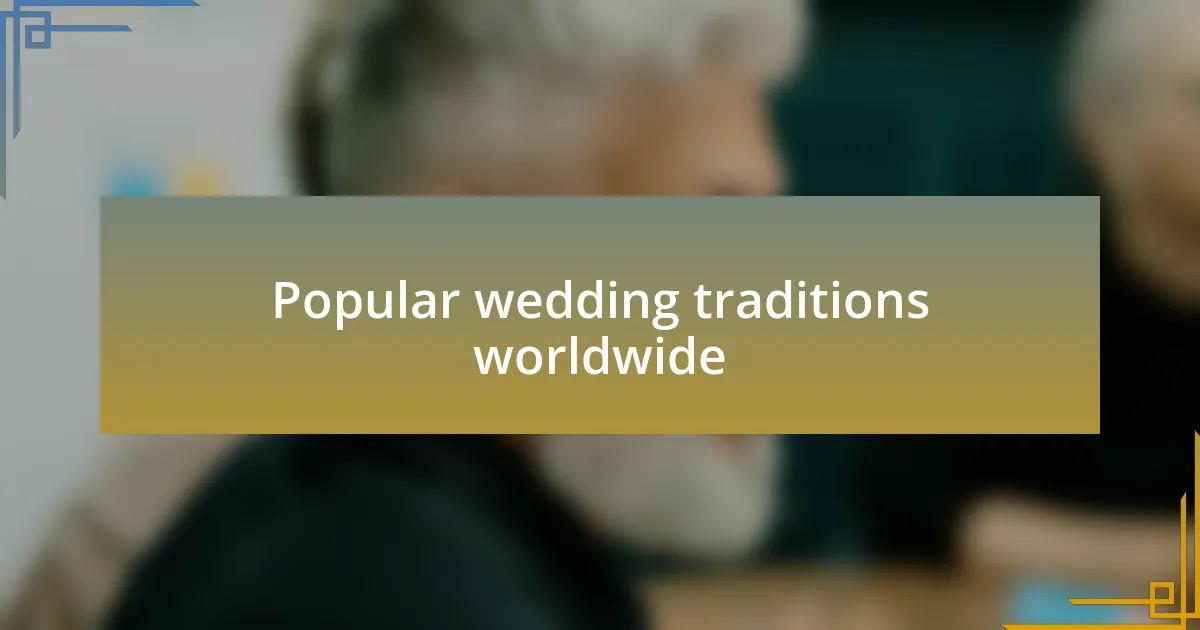
Popular wedding traditions worldwide
Wedding traditions around the world showcase a beautiful tapestry of cultural expressions. For instance, in India, the vibrant and elaborate ceremony known as a “Sangeet” brings families together for an evening of music and dance before the wedding. I still remember the energy of my friend’s Sangeet, where we laughed and danced as if we were all family, reminding me of how traditions can fuse joy with a sense of belonging. Have you ever been part of a gathering where the dance floor felt like an extension of home?
In contrast, the Japanese “Shinto” wedding ceremony embodies a sense of purity and simplicity. The bride and groom often wear traditional kimonos and participate in a ritual called “san-san-kudo,” where they sip sake to symbolize their union. Watching a friend’s Shinto wedding felt serene and almost sacred, emphasizing respect for tradition while also celebrating the couple’s love. It made me ponder: how much does the setting influence the emotions we feel during significant moments in life?
Across the globe in Mexico, the “Lazo” ceremony involves the couple being wrapped together with a cord or rope, signifying their unity. I vividly recall a wedding where the couple’s friends held the lazo tight, creating an intimate moment of connection. This simple act sparked a realization in me—what if the most profound traditions are those that invite others into the narrative of our love story? The way we blend our experiences with these customs can enrich not just the ceremony itself but also the relationships that surround it.
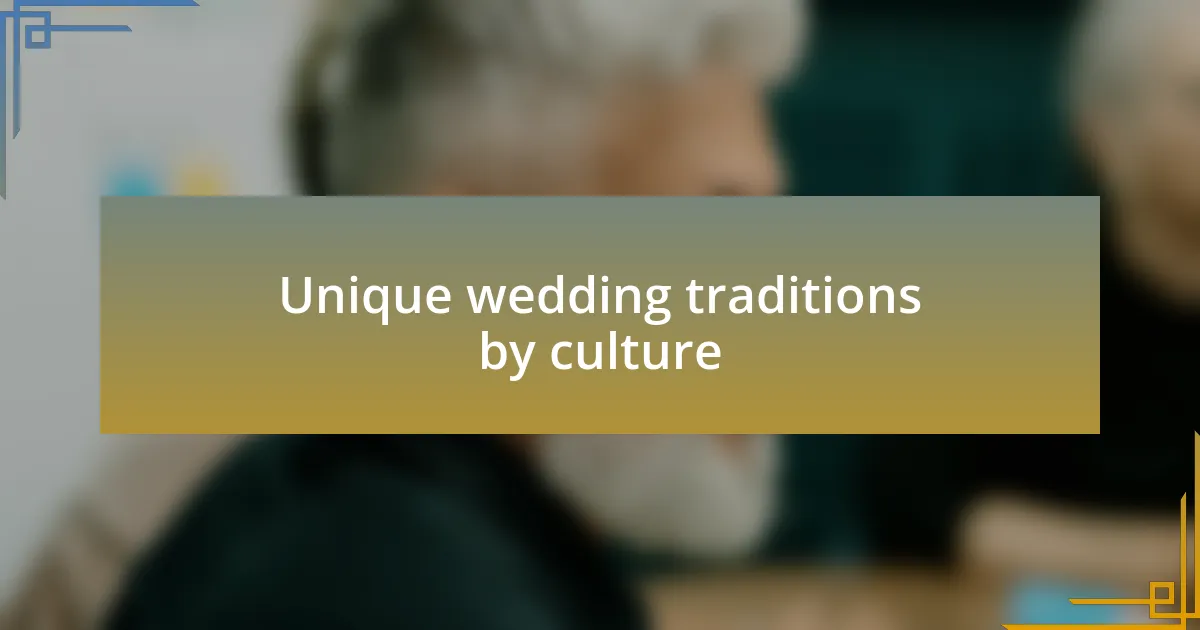
Unique wedding traditions by culture
In Italy, the tradition of “La Tarantella” is a lively folk dance often performed at weddings, where guests join the bride and groom in a whirlwind of energy that celebrates joy and unity. I remember attending a friend’s Italian wedding, where the dance floor transformed into a colorful chaos of laughter and movement. How can a simple dance evoke such excitement and make everyone feel like part of the celebration?
In contrast, the Maasai tribe in Kenya incorporates unique rituals, such as the “jumping of the groom,” where he showcases his strength and agility by leaping as high as he can in front of the community. Witnessing a Maasai wedding was like stepping into a world where love is not only personal but also a collective experience filled with cultural pride. It left me wondering: how do traditions like these help communities reinforce their identity and values through the celebration of love?
The Jewish tradition of breaking a glass at the conclusion of the ceremony serves as a powerful reminder of the fragility of relationships and the beauty of commitment. At one wedding I attended, the poignant sound of shattering glass sparked reflections on both joy and sorrow, highlighting the mixed emotions that can accompany marital bliss. Isn’t it fascinating how a single act can weave together layers of meaning that resonate deeply with everyone present?
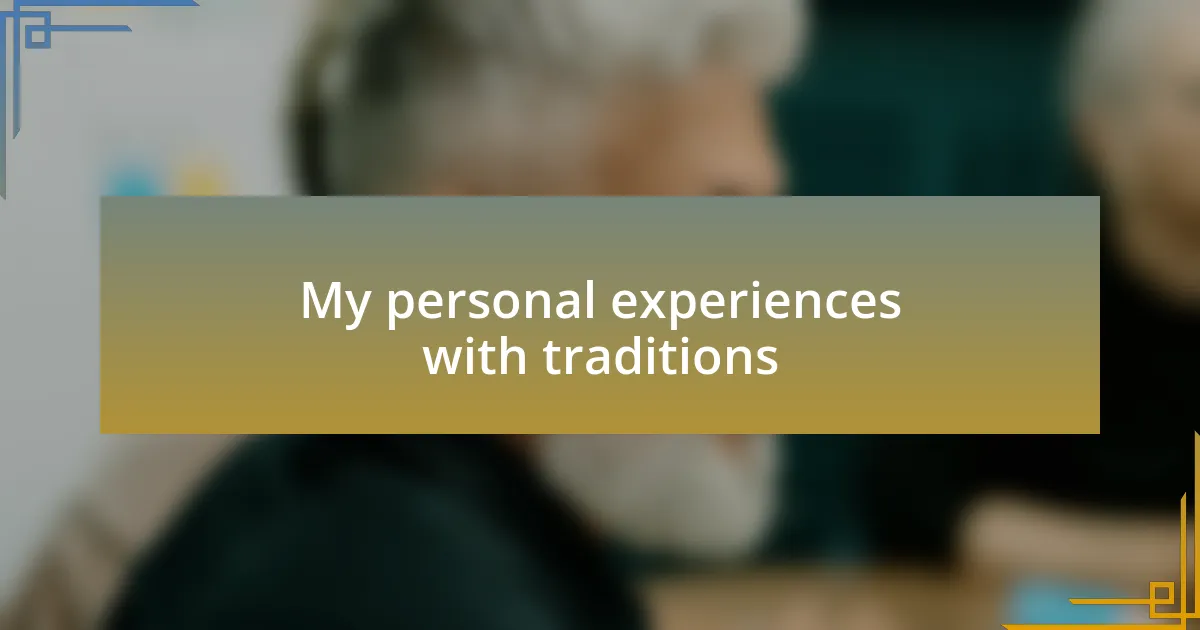
My personal experiences with traditions
The first wedding I ever attended was steeped in my own family’s traditions. As the bride donned her veil, we gathered around to share stories and laughter, each of us reflecting on our similar journeys towards love. This intimate moment made me realize how these rituals can bind us together, almost like a thread weaving through generations, reminding us of who we are.
During a friend’s ceremony, they incorporated the tradition of unity candles. As the couple lit the candles together, I felt an overwhelming sense of connection—as if their love was illuminating the room in a way that transcended just that moment. It made me think: isn’t it incredible how a simple flame can symbolize the merging of two lives into one?
At another wedding, I was touched by the practice where guests could write their wishes for the couple and place them in a decorated box. I loved watching friends jot down heartfelt messages, knowing those words would be cherished for years to come. It left me pondering, how do these acts shape not only the couple’s journey but also our own experiences of love and friendship over time?
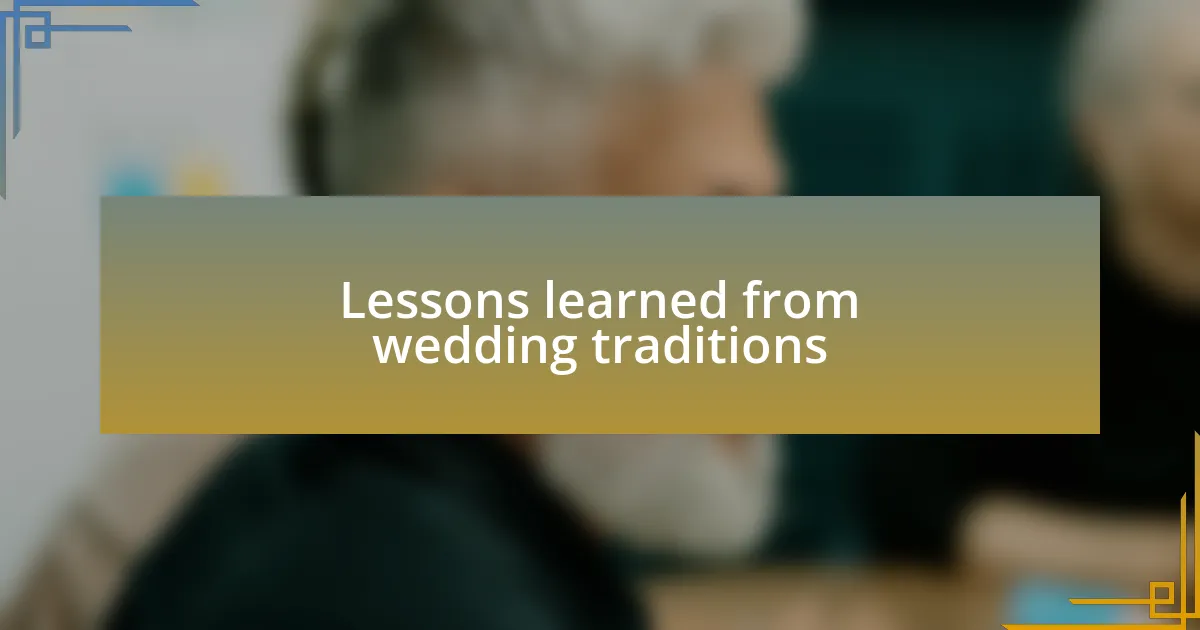
Lessons learned from wedding traditions
There’s something truly profound about the symbolism behind wedding traditions, like the age-old practice of a father walking his daughter down the aisle. When I witnessed this at my cousin’s wedding, I felt a surge of emotion—it’s not just a ceremonial act. It represents a pivotal moment of transition, a melding of past and future. I couldn’t help but wonder, how many hopes and dreams are wrapped up in that one walk?
During a wedding where the couple exchanged family heirloom rings, I was struck by the weight of history in that gesture. It made me reflect on the stories and love that had traversed generations, uniting families in unexpected ways. This practice led me to consider: do these shared tokens have the power to strengthen our connections to one another?
At another event, the couple’s decision to include cultural dances was enlightening. The whole room came alive, celebrating not only their union but also their heritage. I found myself reflecting on how these moments of culture and tradition can bridge differences, teaching us that love knows no bounds. Isn’t it fascinating how a single dance can weave diverse backgrounds into a beautiful tapestry?